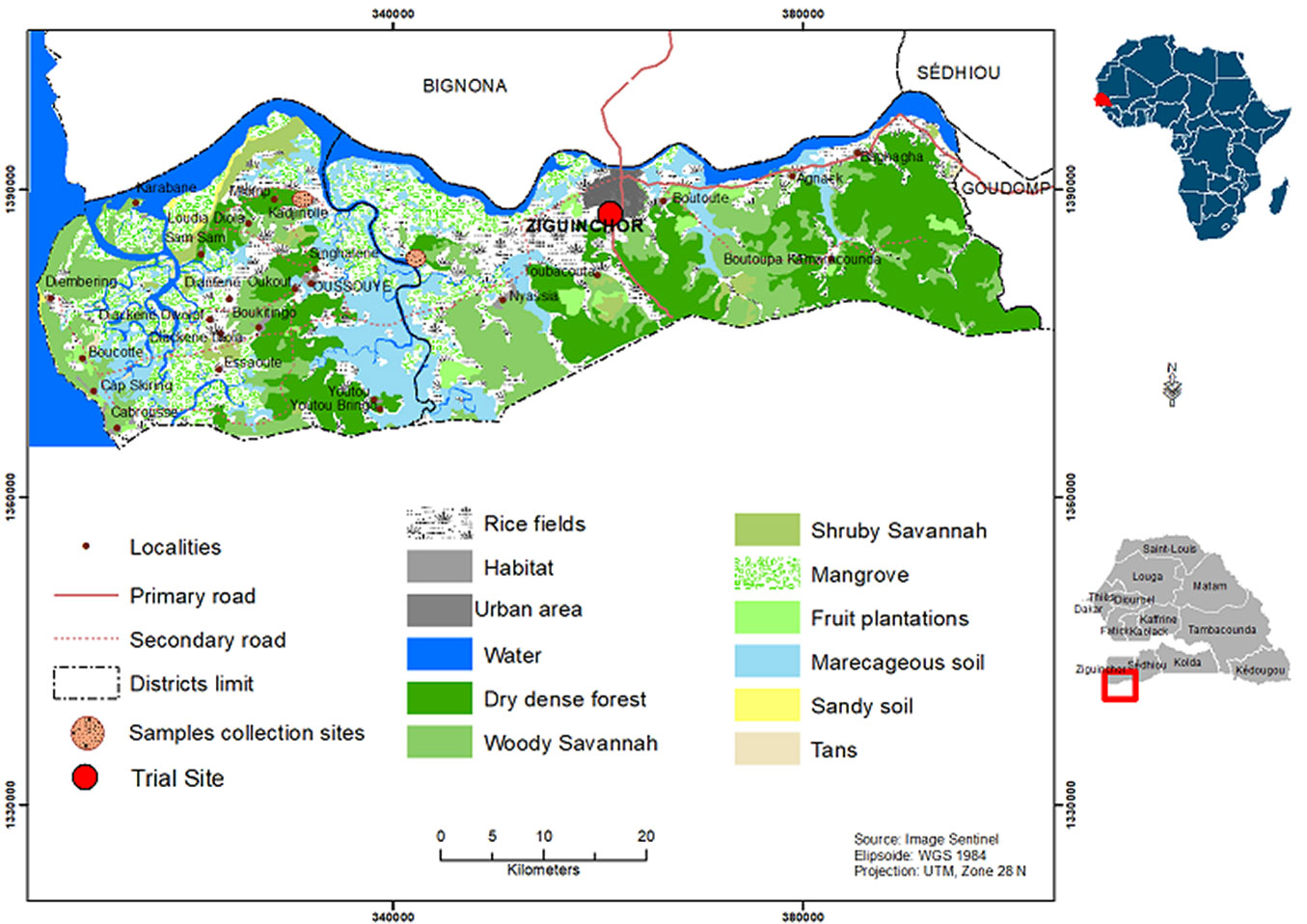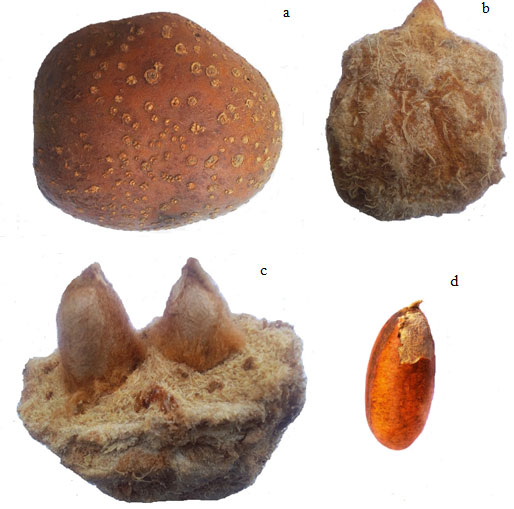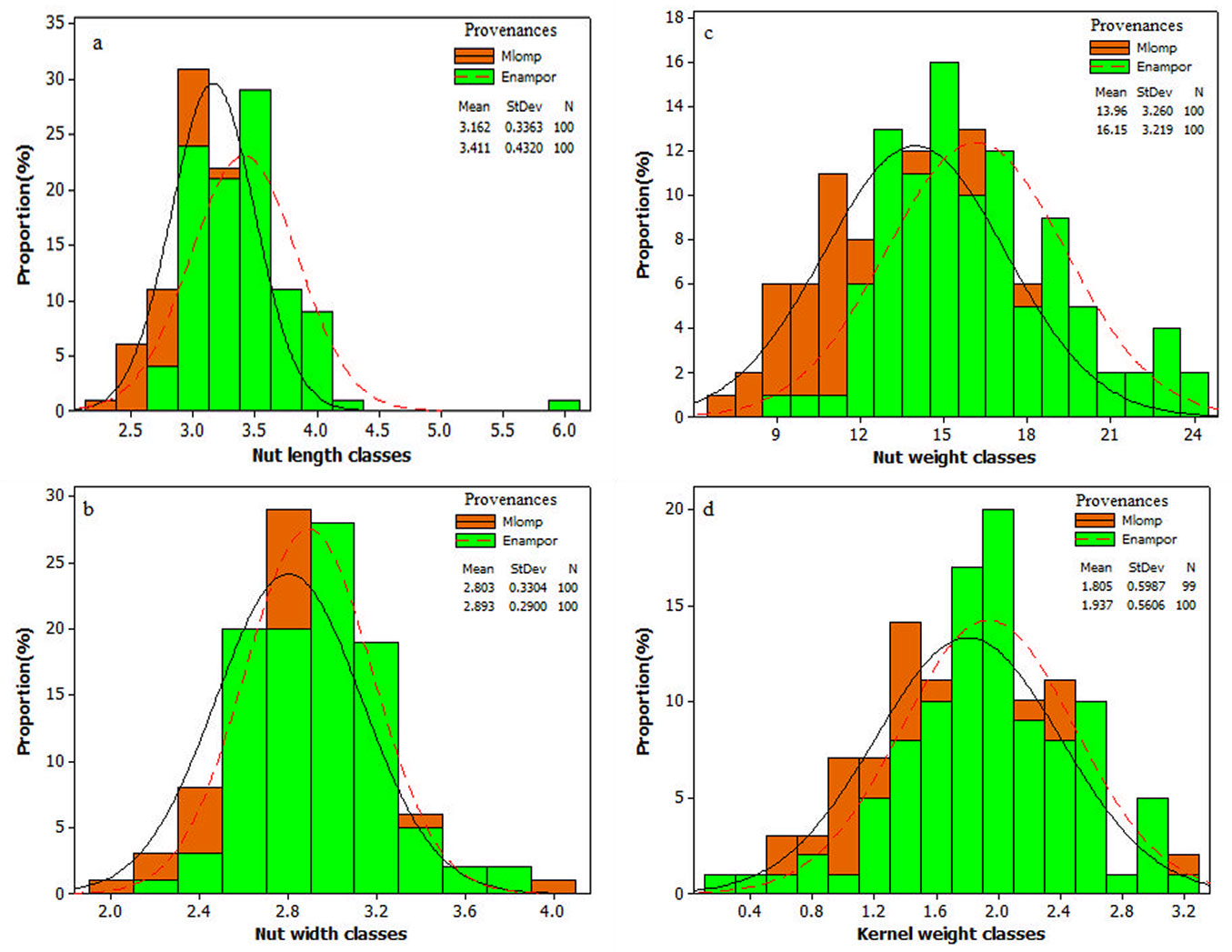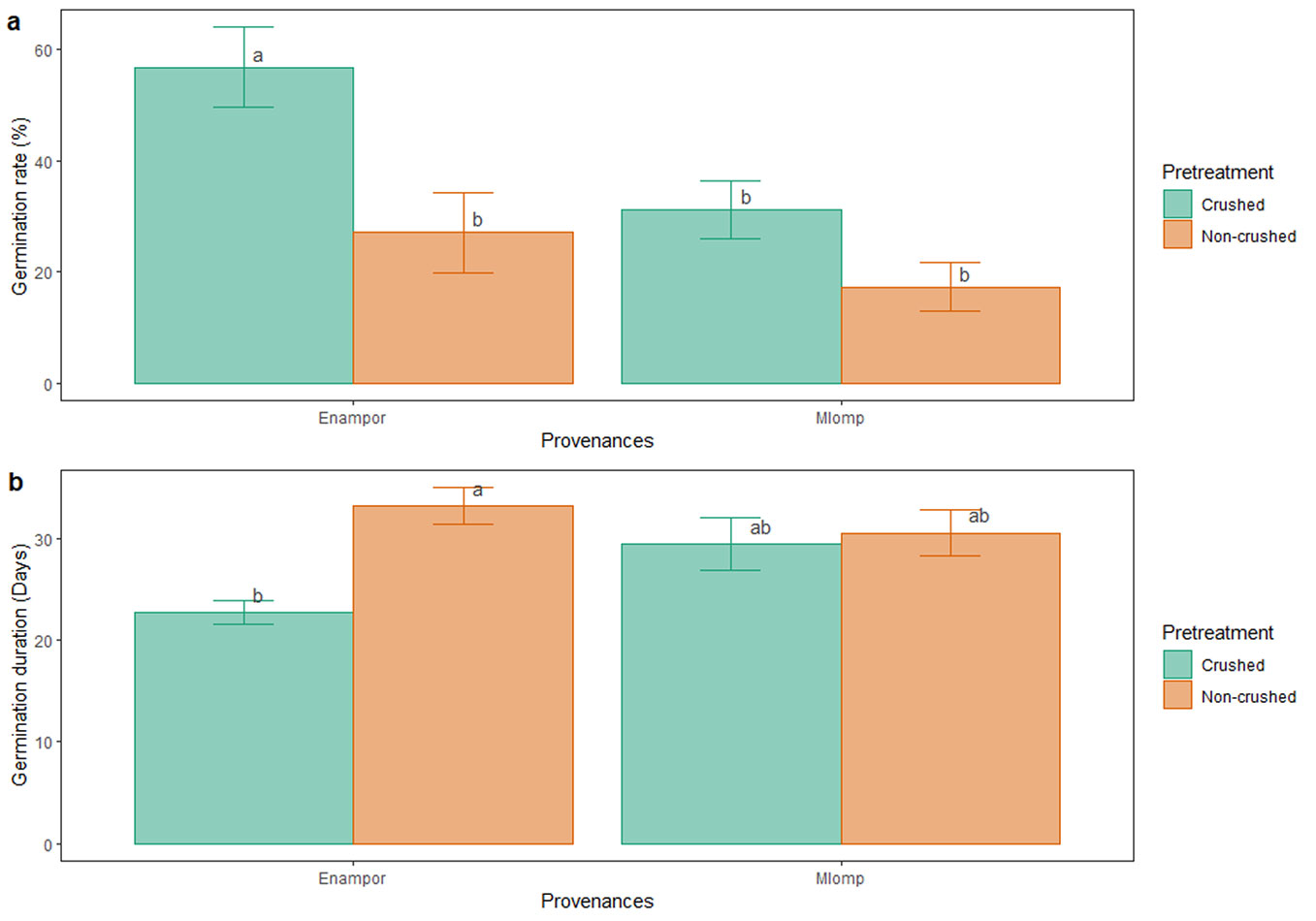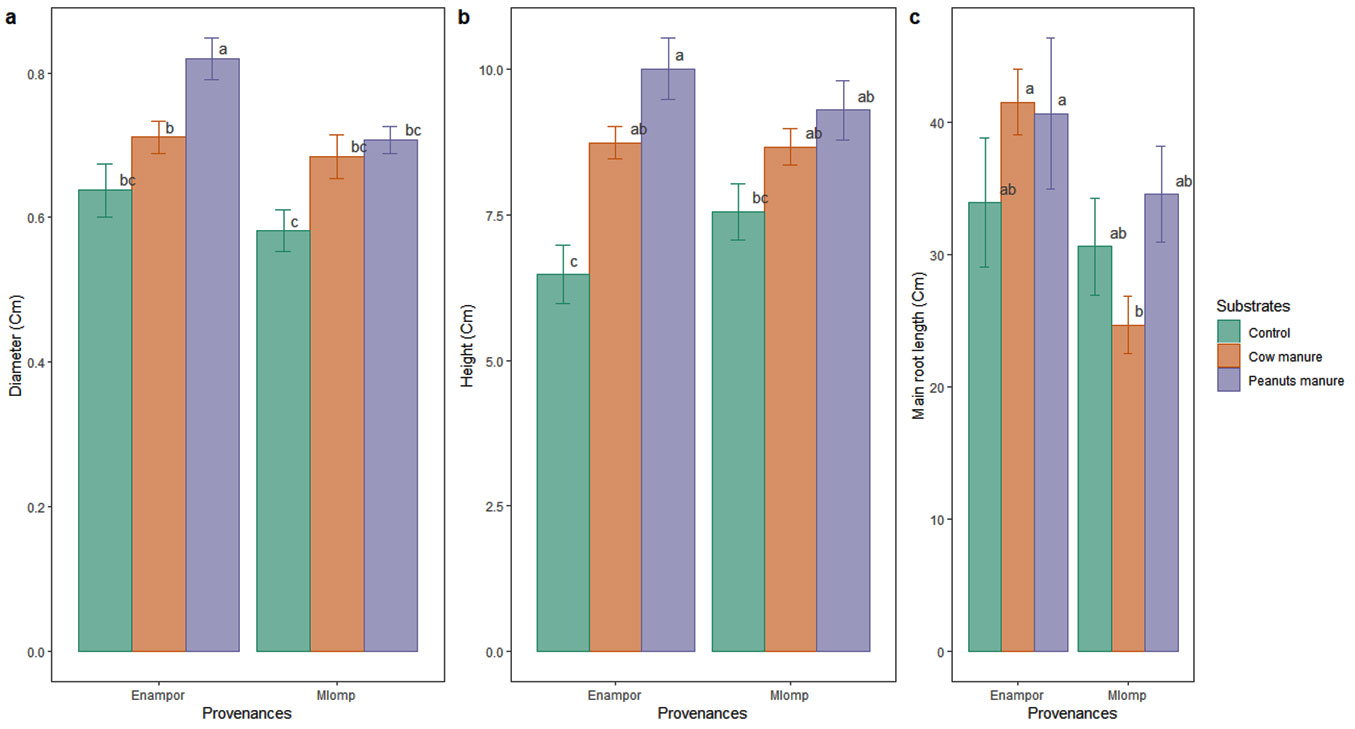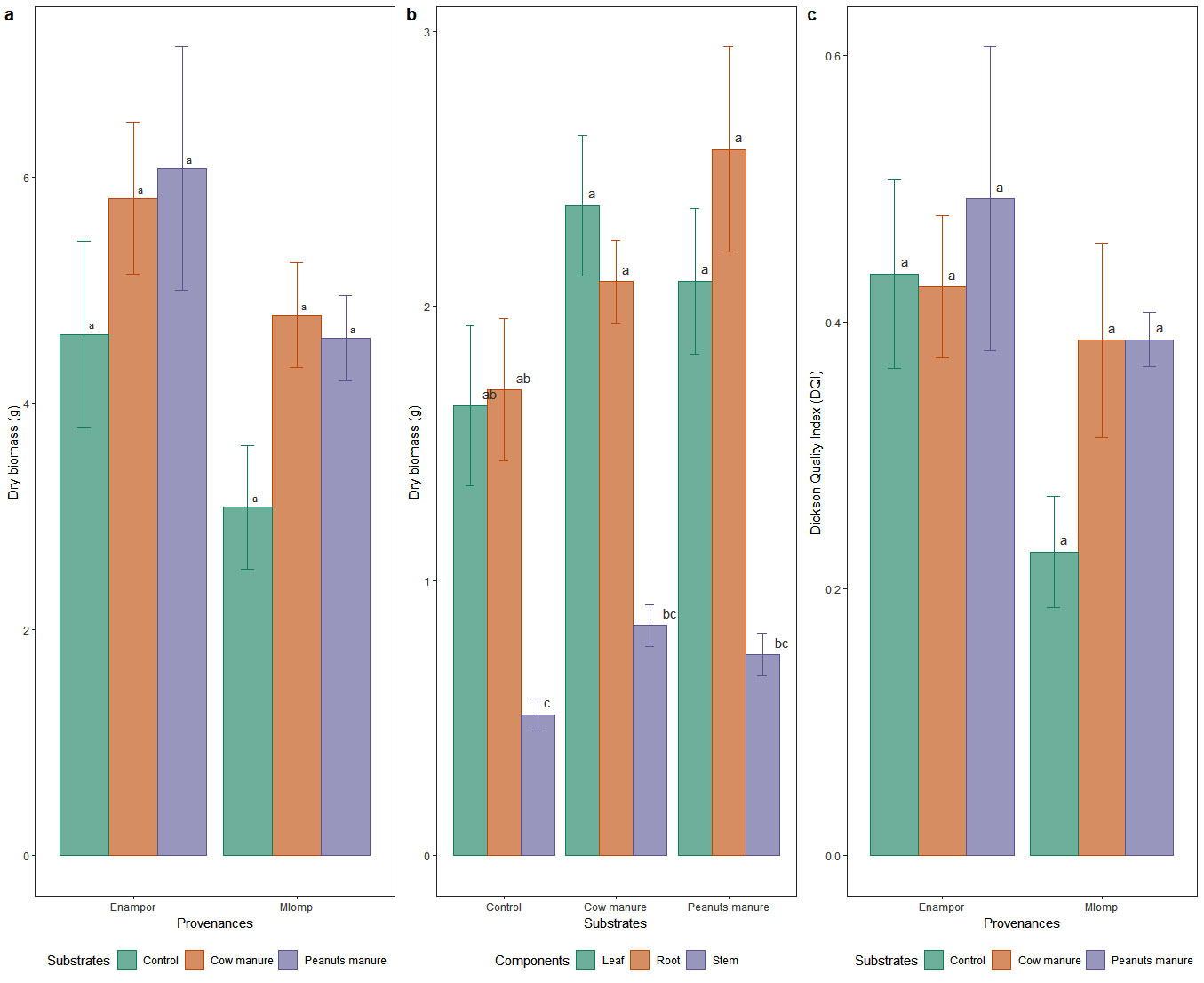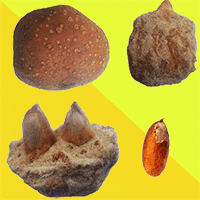
Effects of different nut pretreatments and substrates on germination and seedlings growth of Neocarya macrophylla Sabine in Basse Casamance, Senegal
iForest - Biogeosciences and Forestry, Volume 17, Issue 6, Pages 346-352 (2024)
doi: https://doi.org/10.3832/ifor4528-017
Published: Nov 03, 2024 - Copyright © 2024 SISEF
Research Articles
Abstract
Neocarya macrophylla Sabine (Gingerbread plum) is a tree species that plays an important role in providing ecosystem services. Despite its importance, the diversity and density of N. macrophylla stands have decreased significantly due to natural and anthropogenic factors. There is a need for better knowledge of N. macrophylla seedling production techniques for successful reforestation. This study aimed to evaluate the effects of pre-treatment and substrates on germination and growth of N. macrophylla seedlings. A completely randomized design with three replications and 12 elementary plots of nine polyethylene bags was installed. The three studied factors were provenances (Enampor and Mlomp), pre-treatments (crushed and non-crushed nuts), and substrates (cow and peanuts manures and control-sand). Nut and kernel size and weight, germination, growth parameters (height, diameter, number of leaves and lateral roots, and length of main root), and dry biomass were measured. The results showed that nut size and weight varied significantly (p<0.0005) among the provenances. Nuts from Enampor were longer (3.41 ± 0.04 cm), wider (2.89 ± 0.03 cm), and heavier (16.15 ± 0.32 g) than those from Mlomp. Pretreatments significantly (p<0.05) influenced germination rate and duration. Crushed nuts had the best rate (43.27 ± 5.19%) and germinated significantly faster (26.23 ± 1.61 days) than non-crushed nuts. Substrate significantly influenced growth parameters and biomass. Peanuts manure promoted a larger growth in height (8.92 ± 0.17 cm), diameter (0.072 ± 0.01 cm), leaf production (10.05 ± 0.18), and biomass (1.80 ± 0.20 g). Leaves (2.03 ± 0.16 g) and roots (2.10 ± 0.16 g) produced more biomass than stems (0.69 ± 0.05 g). The best performance of Neocarya macrophylla seedlings was recorded in peanuts and cow manures.
Keywords
Neocarya macrophylla, Germination, Performance, Provenance, Pretreatment, Substrates
Introduction
Trees play an important role in the functioning of the savannah ecosystems ([45]) by maintaining soil chemical properties and nutrient cycling ([39]) and providing direct or indirect human nutrition for developing countries particularly ([6]). Wild edible plants are incredibly nutrient-dense and can essentially serve as a micronutrient supplement ([19]). Many of these edible plants are used as food supplements or as a means of survival during famine or drought seasons ([16]). People in the western Sahel consume wild and cultivated edible plants to satisfy their nutritional requirements ([44]). Neocarya macrophylla is among the useful forest trees in Senegal, and it is frequently used as an association in agroforestry systems ([21]), food ([9]), and base for various beverages ([5]). N. macrophylla has been reported to contain beneficial oils, proteins, minerals, carbohydrates, lipids, sugar, vitamins, and folate ([10], [31], [12]). Pharmacologically, N. macrophylla contains antioxidants, flavonoids, diterpenoids, antimicrobial potential, bioactive compounds, and amino acids ([26], [17]).
Despite their importance, stands of some woody species such as N. macrophylla are subject to degradation caused by human activities and the negative effects of climate change. Soil properties, one of the important factors affecting the distribution and growth of plants, play an important role in the ecology of vegetation ([43]). These climatic phenomena, combined with poor soils, have resulted in poor harvests that do not match the food needs of rural households throughout the year ([22]). Previous studies have reported on N. macrophylla ecology ([32], [2], [21]) and nutritional and functional contents of N. macrophylla fruit and kernels ([4], [49], [8], [18], [25]). However, few studies have documented N. macrophylla seedlings production techniques. Seedlings production of tree species is one of the most important activities in the restoration of forest ecosystems ([15]). Faced with the deterioration in the diversity and density of N. macrophylla stands caused by natural and anthropogenic factors, there is a need for better knowledge of N. macrophylla seedling production techniques for effective reforestation. This research aims to assess the effects of pre-treatment and substrates on nut germination and growth of N. macrophylla seedlings.
Material and methods
Study area
The experimental site was located in the Experimental Farm of Agroforestry department, Assane Seck University in Ziguinchor City and Province, Senegal (12° 33′ 39.35″ N, 16° 15′ 41.33″ W - Fig. 1). The Ziguinchor region is characterized by a South Sudanese coastal climate ([42]). Relative humidity is influenced by the Harmattan (dry season with dusty winds) and is low in January, February, and March. It is characterized by the existence of two seasons: a dry season from November to May and a rainy season from June to October ([33]). This zone is also characterized by an average rainfall of between 1300 and 1500 mm per year ([34]).
Collection and preparation of vegetal material
Mature fruits of N. macrophylla were collected from two localities, namely Mlomp and Enampor, which are the two provenances considered in this study. Mlomp is located at a longitude of 16° 34′ 26.09″ W and latitude of 12° 33′ 37.60″ N and Enampor at a longitude of 16° 26′ 42.68″ W and latitude of 12° 30′ 53.37″ N (Fig. 1). N. macrophylla fruits were cleaned to separate the pulp from the nut (Fig. 2). Nuts were extracted by removing the pulp (mesocarp and exocarp). After extraction, nuts were crushed to obtain kernels.
Experimental design and treatments
The design used was a completely randomized design with three blocks and factors (provenance, pretreatment, and substrate). The experimental design was installed on a plot with 28.75 m² (11.5 × 2.5 m) divided into three blocks. Each block was made up of 12 elementary plots with a square shape of 0.25 m2 (0.5 × 0.5 m). In each elementary plot, nine polyethylene bags with a capacity of 324 cm3 (9 × 12 × 3 cm) were used, totaling 324 polyethylene bags. Two fruit provenances (Enampor and Mlomp) were used to characterize and germinate nuts. Before sowing, nuts were subjected to two pretreatments (non-crushed and crushed). The substrates including 2/3 cow manure +1/3 sand, 2/3 peanuts manure + 1/3 sand, and control (100% sand) were used and potted on polyethylene bags. All combinations of factors (2 provenances × 2 pretreatments × 3 substrates) consisted of three replications in a completely randomized design with factorial arrangement. Sowing was carried out on August 18, 2022, with one seed or two kernels per polyethylene bag. A thinning was done 90 days after sowing (DAS) leaving one seedling per polyethylene bag. Weed control was done regularly during the time of the experience. In addition, the seedlings were watered daily.
Data collection
Nuts and kernels size and weight
After extraction, a randomly selected batch of 100 pulpless nuts from each provenance was used to facilitate crushing and to measure the length, width, and weight of nuts and weight of kernels. The length and width of the nuts were measured using a caliper. The nuts were crushed using a machete and a board to separate the kernels from the nuts. After crushing, the kernels were weighed. The nuts and kernels were weighed using a 10-4 precision balance.
Germination
Germination of nuts and kernels was recorded daily over 90 DAS. A nut or kernel is considered germinated when the cotyledons separate to allow the radicle to emerge ([14]). The number of emerged nuts or kernels was counted and the plumule emergence was considered to determine the germination rate and duration. The germination rate was calculated per provenance and pretreatment using the following formula (eqn. 1):
where G is the germination rate (%), Ng is the number of germinated nuts per kernel, and Nt is the total number of nuts per kernel. The germination duration in terms of days after sowing (DAS) was recorded to determine the average germination duration.
Growth and biomass parameters
At 150 DAS, growth and biomass parameters (diameter, height, main root length, number of leaves and lateral roots, and biomass) were measured, counted, or weighed. The diameter was measured at the collar of each seedling using a caliper. Height growth was measured using a graduated ruler. Leaves were counted for each seedling from bottom to top at the same time as the diameter and height measurements.
A random sample of one seedling per elementary plot was selected to count the number of lateral roots, measure the main root length, and determine the biomass of the seedlings. After sampling, digging was carried out to remove seedlings using a shovel. The seedlings in polyethylene bags were taken to the Agroforestry Department lab and the polyethylene bags were cut with a blade to separate the substrate from the seedlings. The seedlings were then cleaned to remove the substrate. After cleaning, the main root length was measured using a ruler, and the number of lateral roots was counted. The seedlings were then cut with secateurs to separate the different components (leaves, stem, and roots). Each component was rolled up on paper and numbered to make drying easier. After drying in an oven for 48 hours at 100 °C, each component was weighed using a 10-4 precision electronic balance to determine the dry biomass. With growth and biomass data, Dickson’s quality index (DQI) was calculated using the following formula (eqn. 2):
where TDM is the total dry mass, H is the height, D is the diameter, SDM is the shoot dry mass, and RDM is the root dry mass.
Data analyses
Nut and kernel data were analyzed using histogram and normal distribution density. The proportions of small-size and lower-weight nuts and kernels were calculated by centering the values of random variables (Xi) as follows (eqn. 3):
where bar{X} is the variable mean. To evaluate the effects of the provenances, pretreatments, and substrates on the variables studied, multi-way analyses of variance (ANOVA) and Tukey’s test were performed (α = 0.05) using R software ([37]). The results are expressed as means ± standard error (SE). The relationship between nuts and kernels size and weight and seedlings growth parameters were analyzed by Pearson’s correlation and regression with α = 0.05.
Results
Characteristics of nuts and kernels
Due to variations between the provenances, the nut’s length, width, weight, and kernel weight were used to investigate the distribution of nut size within the two provenances (Fig. 3). The nut’s length varied between 2.7 and 6.1 cm and 2.2 and 3.9 cm, respectively, at Enampor and Mlomp. The small size constituted 56% and 49% for Enampor and Mlomp, respectively. The nut widths of different provenances varied from 1.9 to 3.9 cm, overall distributions of smaller nuts were 44% and 43% for Enampor and Mlomp, respectively. The nut weight of different provenances varied from 7.9 to 24.4 g, with Enampor having 55% lower nut weight and Mlomp 48%. The kernel weight values ranged from 0.18 to 3.24 g with 49% and 47% of lower kernel weight for Enampor and Mlomp, respectively. This indicated that provenances affected the size and weight of nuts and kernels of N. macrophylla. Based on the normal distribution, the small size (length) nuts dominated the longer in Enampor. But the larger and heavier nuts and kernels dominated the smaller and lower weights. Analysis of variance showed a significant difference (p<0.05) in seed length, width, and weight between the two provenances. Seeds from Enampor were significantly longer (3.40 ± 0.04 cm) than those from Mlomp (3.16 ± 0.03 cm). In terms of width, seeds from Enampor (2.89 ± 0.03 cm) were wider than those from Mlomp (2.80 ± 0.03 cm), as were the weights of seeds from Enampore (16.15 ± 0.32 g) and Mlomp (13.96 ± 0.33 g). The difference was not significant (p>0.05) for the kernel weight between provenances but in absolute value, the kernels from Enampore (1.94 ± 0.06 g) were heavier than Mlomp (1.8 ± 0.06 g).
Fig. 3 - Structure of nuts length (a), width (b) and weight (c) and kernels width (d) according to provenances.
Correlation and regression analyses were applied to investigate the relationship between variables of nuts and kernels. Strong correlations between nut width and weight (r = 0.80), nut length and weight (r = 0.72), and nut and kernel weights (r = 0.60) were noticed (Fig. S1 in Supplementary material). Allometric analysis showed a good relationship between nut weight and width characterized by negative intercepts, positive slopes, and coefficient of determination (R2) varying between 0.54 and 0.74. The relationships between nut weight and length, and kernel and nut weights were characterized by negative and positive intercepts at Mlomp and Enampor, respectively, positive slopes and R2 ranging from 0.23 to 0.61 (Fig. S2 in Supplementary material).
Nuts and kernels germination
Provenances influenced significantly (p=0.0017) the germination rate of N. macrophylla nuts. Germination duration was not significantly influenced by nut provenance. Nuts from Enampor had a higher germination rate (42.81 ± 6.17%) compared to those from Mlomp (24.56 ± 3.71%). There was a significant difference in germination rate and duration between pre-treatments. Crushed nuts had a higher germination rate (43.27 ± 5.19%) with germination duration (26.22 ± 1.61 days), while non-crushed nuts had a lower germination rate (21.89 ± 4.16%) with a longer duration (31.89 ± 1.42 days). The interaction between provenance and pre-treatment had a significant influence (p<0.05) on germination rate and duration (Fig. 4). The best rates were obtained for crushed seeds (56.79 ± 7.16 and 31.11 ± 5.19%) in Enampor and Mlomp, respectively. Crushed nuts from Enampor (22.67 ± 1.17 days) took less time to germinate compared to those from Mlomp (29.42 ± 1.81 days).
Seedling growth, biomass, and quality parameters
The analysis of variance showed that there was a significant difference (p<0.05) in growth parameters (diameter, height, and number of leaves) and plant biomass between the substrates. Peanuts manure recorded a higher seedling diameter (0.72 ± 0.01 cm) and height (8.92 ± 0.17 cm), followed by cow manure. The lowest mean diameter (0.58 ± 0.01 cm) and height (6.68 ± 0.18 cm) of seedlings were noticed in the control. The interaction between provenance and substrate had a significant effect (p<0.05) on plant diameter and height (Fig. 5). Peanuts manure favored a higher growth in diameter of Enampor (0.76 ± 0.01 cm) and Mlomp (0.68 ± 0.01 cm) plants. The greatest heights were recorded in peanut manure for seedlings from Enampor (9.04 ± 0.23 cm) and Mlomp (8.75 ± 0.24 cm). Cow manure also promoted significant growth in relative height for Enampor (8.18 ± 0.14 cm) and Mlomp (7.96 ± 0.19 cm).
Fig. 5 - Diameter (a), height (b) and main root length (c) of seedlings according to provenances and substrates.
As for the number of leaves, peanut manure had the highest number of leaves (10.05 ± 0.18), followed by cow manure (8.91 ± 0.12) and control (7.92 ± 0.25). Analysis of variance showed that the interaction provenance and substrate did not significantly (p>0.05) affect the number of leaves. Seedlings grown on peanut manure had more leaves in Enampore (10.28 ± 0.25) than in Mlomp (9.74 ± 0.25), followed by those grown on cow manure in Enampor (8.98 ± 0.16) and Mlomp (8.81 ± 0.16) and finally those grown on control in Enampore (7.89 ± 0.36) and Mlomp (7.95 ± 0.33).
The results indicated that different substrates had no significant effects on the number of lateral roots. The interaction provenance and substrate did not significantly (p>0.05) affect the number of lateral roots. However, substrates affected significantly (p<0.05) the length of the main root (Fig. 5). The plants in cow (41.53 ± 2.47 cm) and peanut manure (40.68 ± 5.70 cm) for Enampor were longer than those in cow dung (24.67 ± 2.18 cm) and peanuts manure (34.68 ± 2.52 cm) for Mlomp.
Significant differences (p<0.0005) in dry biomass were detected between the different seedling components. The highest biomass was obtained from the roots (2.11 ± 0.16 g) followed by the leaves (2.03 ± 0.16 g). Stems had the lowest amount of biomass (0.69 ± 0.05 g). Substrates influenced biomass. Seedlings grown on peanut manure (1.80 ± 0.20 g) and cow manure (1.76 ± 0.15 g) produced more biomass than those grown on control (1.28 ± 0.16 g). The interaction between provenance and substrate did not significantly affect biomass, but the interaction between substrate and component did significantly (p<0.05) influence dry biomass. The roots of seedlings grown in peanut manure (2.57 ± 3.93 g) and cow manure (2.09 ± 4.87 g) had more biomass than those in control (1.70 ± 2.29 g). Regarding leaves and stems, seedlings from cow and peanut manures yielded more biomass (Fig. 6).
Fig. 6 - Variation of biomass according to provenances and substrates (a), substrates and components (b) and seedlings quality (c).
The quality of seedlings varied significantly from 0.45 ± 0.045 to 0.33 ± 0.033 for Enampor and Mlomp provenances, respectively. The substrates and the interaction provenances × substrates did not influence significantly (p>0.05) seedlings quality (Fig. 6). The analysis indicated that the Enampor provenance provided better quality, growth, and biomass of seedlings using different substrates.
Correlation and regression analyses showed the relationship between seedlings’ growth, biomass, and quality parameters. The correlation analysis revealed that biomass was strongly correlated to diameter (r = 0.60), height (r = 0.59), and main root length (r = 0.59). Positive correlations between diameter and height (r = 0.42) were noticed. The quality of seedlings was positively correlated with biomass (r = 0.21), diameter (r = 0.11), and height (r = 0.6). However, a significant negative correlation was found between the quality of seedlings and main root length (Fig. S1 in Supplementary material). Regression analysis showed a linear allometric relationship between biomass and diameter, and height characterized by negative intercepts, positive slopes, and a coefficient of determination (R2) of 0.35 (Fig. S2 in Supplementary material). The relationship between biomass and main root length was characterized by positive intercept (2.66), positive slopes (0.06), and R2 (0.34 - Fig. S3 in Supplementary material).
Discussion
Effects of provenances on nut and kernel Characteristics
The nut widths varied from 1.9 to 3.9 cm according to the provenances. N. macrophylla produced glabrous, ellipsoid drupes that are yellowish-brown in color and have gray warts on their surface, usually 2.3-3.5 cm of internal width and 4-5 cm length, with an endocarp surrounded by pulp ([13]). Provenances influenced significantly the nut’s size and weight. The larger and heavier nuts were recorded in Enampor. The differences in environmental factors and genotypic information between provenances can affect the phenotype of nuts. The genetic effects had complementary interactions, where the small size introduced by the maternal parent prevented full expression of the large size ([23]). The distribution of nut size and weight was normal, analogously to the distribution of seed length and width in Swietenia macrophylla ([36]). The results showed the dominance of larger size and heavier nuts over small size and lighter nuts. However, a contrasting result was found by Hossain et al. ([23]) who reported dominance of small seed size over large seed size with additive effect.
Several significant correlations between various variables of nut size and weight in 100 seed lots were found. Larger sizes were significantly associated with heavier nuts, while nut and kernel weight were significantly correlated. The positive relationship between nut size and weight was similar to other studies on sunflowers ([28]), Balanites aegyptiaca ([1]), and Swietenia macrophylla ([36]).
Effects of pretreatment on germination rate and duration
Germination rate varied from 21.89 ± 4.16% to 43.27 ± 5.19%, according to provenance and pretreatment. Guimbo et al. ([20]) reported the germination rate of N. macrophylla varying from 58.40 ± 2.93% to 89.53 ± 1.61%. Also, in this study germination duration was influenced by the pretreatment: crushed nuts take less time to germinate than non-crushed nuts. To ensure rapid and homogeneous germination, it was necessary to crush the nuts before sowing ([20]). Enampor provenance characterized larger nuts had a higher germination rate with shorter germination duration. The mean germination time of small seeds was slightly lower than large seeds ([28]). Saranga et al. ([46]) found higher mean germination time in large seeds compared to small seeds. The highest germination was recorded for medium-size seeds compared to smallest-size seeds ([36]). Furthermore, to overcome the physical dormancy imposed by the N. macrophylla nuts, we used pre-treatments which significantly influenced the germination rate and duration, as crushed nuts had better germination rate with shorter duration. This confirmed that seed pre-treatment increased germination kinetics and the germination rate ([27]).
Effects of substrates on growth, biomass and quality parameters of seedlings
In this study, the substrate significantly affected the growth and biomass parameters of N. macrophylla seedlings. The addition of substrates into the nursery has been reported to substantially improve the growth and root length of fragrant rice seedlings ([40]). A study on sour jujube seedlings ([51]) showed that substrates influenced significantly the overall performance in terms of plant height, diameter, root length, and weight of the root system. In this study, peanut manure produced the best seedling growth and biomass, followed by cow manure. This can be explained by the fact that peanut manure, which consists of groundnut (legume) residues, is very rich in nitrogen and thus more favorable for seedlings’ growth ([50]). Moreover, the plants in cow manure performed better in terms of plant growth and biomass than in the control. These results are in line with those of Ognalaga et al. ([35]) who showed that the effect of cow manure was significant on root number and root length of cassava tubers. According to Bakayoko et al. ([7]), the combination of cow manure and other organic constituents led to an increase in organic litter, increasing the fertility of the soil. This confirmed the second part of our hypothesis, which emphasized organic fertilizer, in particular cow manure, as a key fertilizer that could ensure the growth of plants. In addition, these results confirmed those of Leakey et al. ([29]), who conducted a study on the effect of different substrates on the growth parameters of Gambeya lacourtiana in a nursery. According to Houehoume et al. ([24]), the application of organic matter stimulated the growth of plants.
The correlation between height and diameter was moderately high and positive. The high positive relationships between biomass and diameter, height, and main root length were indicators useful to predict biomass production and future performance. Diameter is generally correlated with various morphological parameters such as height and dry weight ([38]). According to Pearson’s correlation coefficient, there were positive significant correlations among characteristics of growth and biomass of Euterpe edulis seedlings. Height and diameter were the characteristics that most positively correlated with the others. For height, there was a correlation between dry mass and diameter ([47]). Stem diameter is considered the best morphological attribute to forecast field growth, especially because it correlates with seedling weight and root system size ([48]). Significant correlations were found between quality and growth and biomass parameters. While studying seedling quality in forest seedlings, Binotto et al. ([11]) reported that the quality of seedlings was highly correlated with all morphological parameters. However, a negative correlation between quality and root length was noticed. The correlation with Dickson’s Quality Index showed height and stem diameter as important indicators of seedling quality ([30]). The quality of Schinus terebinthifolia seedlings was negatively correlated with most morphological parameters ([3]).
Conclusions
Our study showed that N. macrophylla nuts size and weight varied significantly according to the provenances. Nuts from Enampor were larger and heavier than those from Mlomp. Regarding the pre-treatment, the crushed nuts gave the best germination rate and took less time to germinate than the uncrushed nuts. The type of substrate significantly affected growth parameters and biomass. It appeared that peanut manure stimulated growth in height and diameter, leaf production, biomass production, and the length of the main root more than other substrates. Biomass production varied according to the components of seedlings. The roots recorded more biomass than the other parts of the seedlings. The type of substrates is an important factor in seedling performance.
Acknowledgments
We are grateful to the Laboratoire d’Agroforesterie et d’Ecologie (LAFE) and Assane Seck University of Ziguinchor, Senegal.
References
CrossRef | Gscholar
Gscholar
Gscholar
Gscholar
Gscholar
Gscholar
Gscholar
CrossRef | Gscholar
Gscholar
CrossRef | Gscholar
Gscholar
Gscholar
Gscholar
Online | Gscholar
Gscholar
Gscholar
Gscholar
Gscholar
Authors’ Info
Authors’ Affiliation
Joseph Saturnin Dieme 0000-0002-9094-1378
Boubacar Camara 0000-0002-0340-9704
Fatoumata Dione
Bineta Balde
Department of Agroforestry, Assane Seck University of Ziguinchor, 27000 Ziguinchor (Senegal)
Corresponding author
Paper Info
Citation
Sambou A, Dieme JS, Camara B, Dione F, Balde B (2024). Effects of different nut pretreatments and substrates on germination and seedlings growth of Neocarya macrophylla Sabine in Basse Casamance, Senegal. iForest 17: 346-352. - doi: 10.3832/ifor4528-017
Academic Editor
Daniela Baldantoni
Paper history
Received: Nov 26, 2023
Accepted: Nov 02, 2024
First online: Nov 03, 2024
Publication Date: Dec 31, 2024
Publication Time: 0.03 months
Copyright Information
© SISEF - The Italian Society of Silviculture and Forest Ecology 2024
Open Access
This article is distributed under the terms of the Creative Commons Attribution-Non Commercial 4.0 International (https://creativecommons.org/licenses/by-nc/4.0/), which permits unrestricted use, distribution, and reproduction in any medium, provided you give appropriate credit to the original author(s) and the source, provide a link to the Creative Commons license, and indicate if changes were made.
Web Metrics
Breakdown by View Type
Article Usage
Total Article Views: 6106
(from publication date up to now)
Breakdown by View Type
HTML Page Views: 3560
Abstract Page Views: 1265
PDF Downloads: 1039
Citation/Reference Downloads: 0
XML Downloads: 242
Web Metrics
Days since publication: 404
Overall contacts: 6106
Avg. contacts per week: 105.80
Article Citations
Article citations are based on data periodically collected from the Clarivate Web of Science web site
(last update: Mar 2025)
(No citations were found up to date. Please come back later)
Publication Metrics
by Dimensions ©
Articles citing this article
List of the papers citing this article based on CrossRef Cited-by.
Related Contents
iForest Similar Articles
Research Articles
Conservation of Betula oycoviensis, an endangered rare taxon, using vegetative propagation methods
vol. 13, pp. 107-113 (online: 23 March 2020)
Research Articles
Effects of brassinosteroid application on seed germination of Norway spruce, Scots pine, Douglas fir and English oak
vol. 10, pp. 121-127 (online: 02 October 2016)
Technical Reports
Effects of different mechanical treatments on Quercus variabilis, Q. wutaishanica and Q. robur acorn germination
vol. 8, pp. 728-734 (online: 05 May 2015)
Research Articles
Germination and seedling growth of holm oak (Quercus ilex L.): effects of provenance, temperature, and radicle pruning
vol. 7, pp. 103-109 (online: 18 December 2013)
Research Articles
Influence of mother plant and scarification agents on seed germination rate and vigor in Retama sphaerocarpa L. (Boissier)
vol. 7, pp. 306-312 (online: 08 April 2014)
Research Articles
Forecasting the field performance of Austrian pine seedlings using morphological attributes
vol. 10, pp. 99-107 (online: 13 October 2016)
Research Articles
Substrates and nutrient addition rates affect morphology and physiology of Pinus leiophylla seedlings in the nursery stage
vol. 10, pp. 115-120 (online: 02 October 2016)
Research Articles
Combined pre-hardening and fall fertilization facilitates N storage and field performance of Pinus tabulaeformis seedlings
vol. 9, pp. 483-489 (online: 07 January 2016)
Research Articles
Seedling quality and short-term field performance of three Amazonian forest species as affected by site conditions
vol. 17, pp. 80-89 (online: 21 March 2024)
Technical Reports
Nursery practices increase seedling performance on nutrient-poor soils in Swietenia humilis
vol. 8, pp. 552-557 (online: 09 December 2014)
iForest Database Search
Search By Author
Search By Keyword
Google Scholar Search
Citing Articles
Search By Author
Search By Keywords
PubMed Search
Search By Author
Search By Keyword

